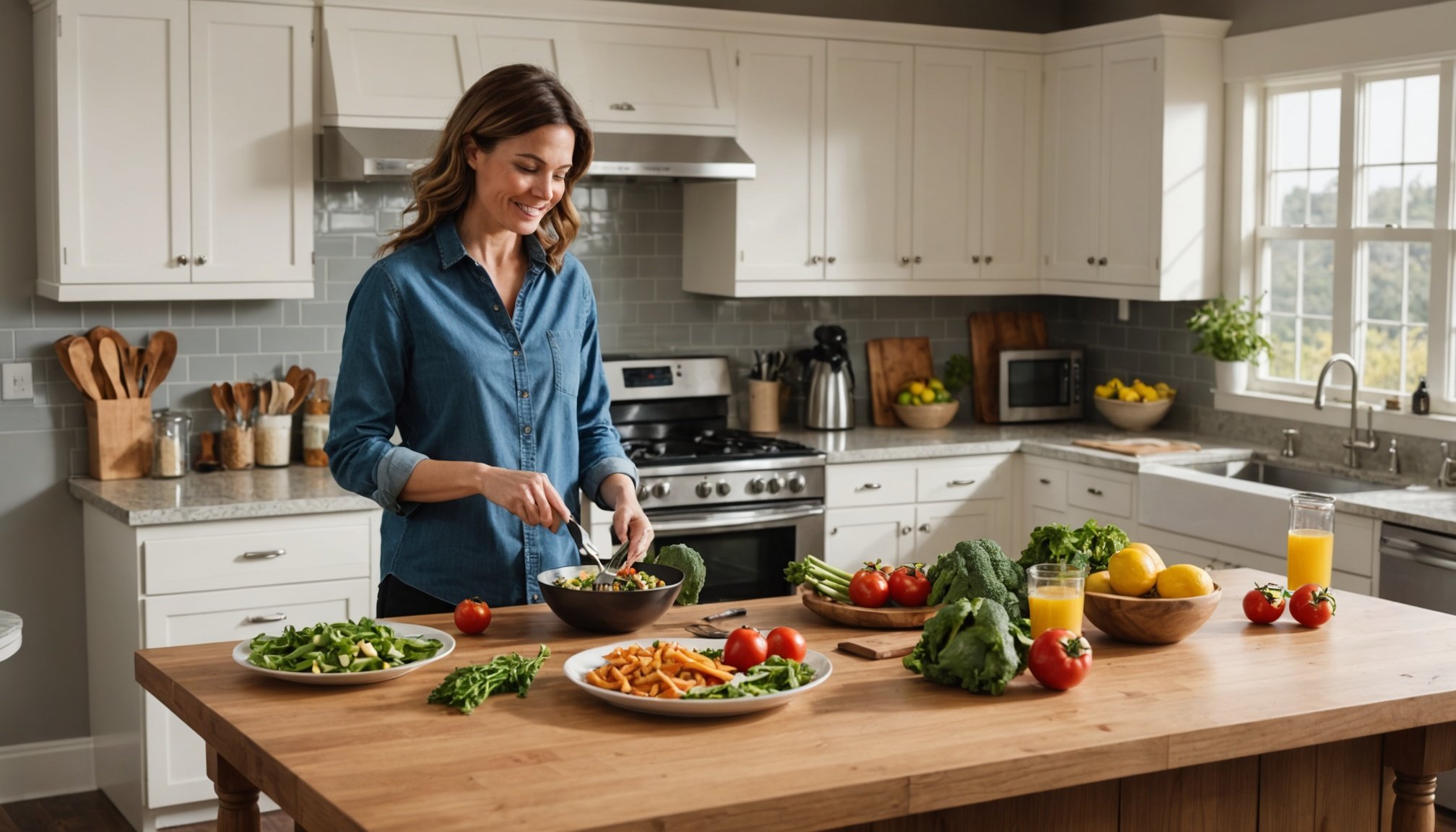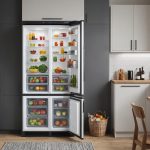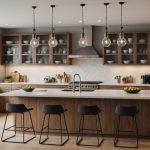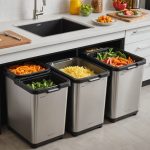Importance of Kitchen Island Positioning
Positioning a kitchen island strategically can significantly enhance meal prep efficiency. A well-placed island creates a central hub in the kitchen, offering extra workspace, especially valuable during elaborate meal preparations. This centralization simplifies access to essential appliances and ingredients, streamlining the entire cooking process and reducing unnecessary steps.
Kitchen island design plays a crucial role in facilitating seamless workflow and accessibility. Efficient positioning allows for easy movement between the sink, stove, and refrigerator – often referred to as the “kitchen triangle”. Maintaining clear pathways within this triangle is critical for minimizing clutter and optimizing time spent moving between stations.
Also read : Revamp your culinary space: unlock healthier eating habits with a smart waste sorting system
Healthy cooking habits are often supported by a thoughtfully designed island layout. With more organized and efficient prep spaces, planning and preparing balanced meals becomes less cumbersome. This encourages consistent cooking practices, fostering habits that prioritize fresh ingredients and home-cooked meals over more processed options.
A kitchen’s overall layout can profoundly impact cooking behaviours. An island designed with well-considered dimensions and positioning enhances interaction with the space, making meal preparation feel more intuitive and enjoyable. When users experience a seamless workflow and accessibility, they are more inclined to embrace a balanced cooking routine. Therefore, a carefully designed kitchen can promote both efficiency and healthy eating.
Also to discover : Revitalize your kitchen: unlock the benefits of smart acoustic panel placement to reduce stress and control overeating
Optimizing Kitchen Island Layout
Designing a kitchen layout that maximizes space efficiency while enhancing your cooking workflow can significantly improve your culinary experience. The right layout allows for effortless movement and effective use of kitchen space.
Ideal Measurements for Kitchen Islands
The ideal kitchen island dimensions often depend on the overall size of your kitchen and the planned usage. A standard island typically measures 2 to 3 feet wide and about 4 to 7 feet long. It’s essential to ensure at least 3 feet of clearance around the island to maintain a comfortable cooking workflow and promote space efficiency.
Common Layout Configurations
Kitchen islands come in various configurations, each offering unique advantages for different cooking styles. The L-shaped island is excellent for corner spaces and enhances site lines. A U-shaped configuration provides extensive counter space, perfect for those who enjoy preparing elaborate meals. The Galley style is streamlined, highly efficient for compact areas.
Adapting to Kitchen Size and Shape
When thinking about kitchen layout optimization, consider the dimensions and shape of your kitchen. For smaller kitchens, a compact, moveable island can liberate space while maximizing usability. In larger kitchens, a stationary double-tiered island can significantly boost storage and seating space, enhancing this key area of your home. Consider choosing shapes that complement your existing design to enhance the cohesion of your cooking environment.
Evaluating these factors can greatly influence the ergonomic and aesthetic appeal of your kitchen, providing a seamless and efficient cooking experience.
Enhancing Functionality through Organization
Organizing a kitchen revolves around creating a functional design that boosts efficiency during meal preparation. It requires careful consideration of storage, tool placement, and accessibility.
Smart Storage Solutions
The essence of kitchen organization lies in smart storage solutions. Utilizing drawers and cabinets effectively is vital for optimal storage. Clever use of these spaces can determine how functional your kitchen becomes. Consider integrating pull-out shelves or dividers to store various items systematically, ensuring everything has its place.
Essential Tools Placement
Efficiency in meal preparation is deeply connected to the placement of essential tools. Aim to keep frequently used items within easy reach to streamline your cooking experience. For instance, positioning utensils, cutting boards, and knives near your food preparation zones can save precious time during cooking. This arrangement helps reduce unnecessary movement, making your kitchen routine smoother.
Designing for Accessibility
Designing a kitchen for accessibility involves creating designated zones for specific preparation tasks. Set up areas for chopping, mixing, and cooking, ensuring smooth transitions between each zone. Effective kitchen organization includes bringing commonly used ingredients and tools near their respective zones. This layout supports functional design, facilitating meal preparation efficiency tremendously by reducing effort and enhancing workflow.
Integrating Technology in Kitchen Design
Incorporating kitchen technology into your culinary space offers both functional and aesthetic benefits. From smart appliances to strategic lighting, innovative solutions can transform the heart of your home into a hub of efficiency.
Smart Appliances and Their Placement
Smart appliances enhance cooking efficiency by offering automated and remote control options. For instance, a smart oven that can be preheated via a mobile app allows you to optimize your time outside of the kitchen. Placement is crucial; positioning appliances within an ergonomic layout reduces unnecessary movement, ensuring accessibility and convenience for all tasks.
Use of Lighting in Meal Preparation
Lighting plays a pivotal role in meal preparation. Ambient lighting sets the overall mood, while task lighting is essential for specific activities like chopping vegetables or cooking. However, integrating smart lighting systems can further enhance the effectiveness of your space, allowing you to adjust brightness and colour according to the task or time of day.
Innovations in Kitchen Tools
Recent advances in kitchen tools focus on improving meal prep effectiveness. Automatic stirrers, smart scales, and precision cookers are just a few examples of gadgets that streamline culinary tasks. These tools not only enhance cooking efficiency but also ensure consistent and precise results, turning even the simplest recipes into something extraordinary.
Case Studies and Real-Life Examples
When it comes to transforming a kitchen, real-life examples offer inspiration and practical insights. In both residential and professional settings, well-thought-out kitchen designs can significantly impact efficiency and meal prep success.
Residential Kitchen Transformations
Many homeowners have turned their cluttered cooking areas into models of efficiency and style. Key aspects of successful kitchen design examples include strategic placement of appliances, ample counter space, and optimised storage solutions. These elements not only enhance the kitchen’s functionality but also make meal preparation more enjoyable and less time-consuming. Consider how a simple rearrangement of your kitchen layout could be a game changer.
Professional Chefs’ Kitchen Insights
Professionals in the culinary world often have unique perspectives on kitchen layout strategies. Renowned chefs emphasize the importance of a well-coordinated workspace, where flow is as crucial as aesthetics. Observations from these professionals reveal secrets like maintaining clear zones for each kitchen activity and investing in quality equipment that speeds up preparation processes—practical applications you can adapt at home.
Lessons from Efficient Cooking Spaces
Whether in a compact urban apartment or a bustling restaurant, efficiency is key. Learning from adeptly designed cooking environments can inform your choices, ensuring you adopt best practices suitable for your space. By drawing from these experiences, anyone can enhance their cooking area, leading to greater satisfaction and meal prep success stories aplenty.











